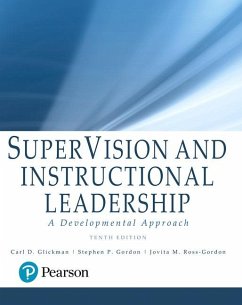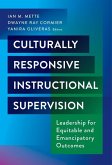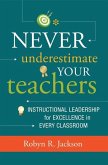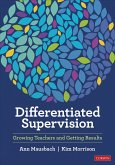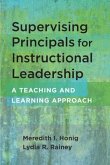Carl Glickman, Stephen Gordon, Jovita Ross-Gordon
Supervision and Instructional Leadership
A Developmental Approach
Schade – dieser Artikel ist leider ausverkauft. Sobald wir wissen, ob und wann der Artikel wieder verfügbar ist, informieren wir Sie an dieser Stelle.
Carl Glickman, Stephen Gordon, Jovita Ross-Gordon
Supervision and Instructional Leadership
A Developmental Approach
- Broschiertes Buch
- Merkliste
- Auf die Merkliste
- Bewerten Bewerten
- Teilen
- Produkt teilen
- Produkterinnerung
- Produkterinnerung
For courses in Supervision (Educational Administration & Leadership) Note: This is the bound book only and does not include access to the Enhanced Pearson eText. To order the Enhanced Pearson eText packaged with a bound book, use ISBN 0134290089. A ground-breaking look at instructional leadership and supervision, updated to keep pace with the purposes, practices, structure, and language of supervision today. The new edition of SuperVision and Instructional Leadership continues the innovative approach that has made it so widely popular, and includes a number of new content changes that bring…mehr
Andere Kunden interessierten sich auch für
![Culturally Responsive Instructional Supervision Culturally Responsive Instructional Supervision]() Culturally Responsive Instructional Supervision54,99 €
Culturally Responsive Instructional Supervision54,99 €![Never Underestimate Your Teachers Never Underestimate Your Teachers]() Robyn R JacksonNever Underestimate Your Teachers35,99 €
Robyn R JacksonNever Underestimate Your Teachers35,99 €![Snapshots of Instructional Supervision Snapshots of Instructional Supervision]() Snapshots of Instructional Supervision14,99 €
Snapshots of Instructional Supervision14,99 €![Supervision Supervision]() Supervision86,99 €
Supervision86,99 €![Differentiated Supervision Differentiated Supervision]() Ann MausbachDifferentiated Supervision32,99 €
Ann MausbachDifferentiated Supervision32,99 €![Supervising Principals for Instructional Leadership Supervising Principals for Instructional Leadership]() Meredith I HonigSupervising Principals for Instructional Leadership37,99 €
Meredith I HonigSupervising Principals for Instructional Leadership37,99 €![Five Big Ideas: Leading Total Instructional Alignment Five Big Ideas: Leading Total Instructional Alignment]() Lisa CarterFive Big Ideas: Leading Total Instructional Alignment28,99 €
Lisa CarterFive Big Ideas: Leading Total Instructional Alignment28,99 €-
-
-
For courses in Supervision (Educational Administration & Leadership) Note: This is the bound book only and does not include access to the Enhanced Pearson eText. To order the Enhanced Pearson eText packaged with a bound book, use ISBN 0134290089. A ground-breaking look at instructional leadership and supervision, updated to keep pace with the purposes, practices, structure, and language of supervision today. The new edition of SuperVision and Instructional Leadership continues the innovative approach that has made it so widely popular, and includes a number of new content changes that bring the subject matter thoroughly up to date. Long recognized as a leading text in the field, this book calls for a collegial approach to instructional supervision; considers the knowledge necessary for successful supervision; discusses interpersonal skills, including different approaches to supervision and how they are used in developmental supervision; presents the technical skills of supervision, such as observing, assessing, planning, implementing, and evaluating; describes the technical tasks of supervision; and deals with the cultural tasks of supervision. A variety of learning aids ensure understanding of the theories and concepts. Invigorate learning with the Enhanced Pearson eText The Enhanced Pearson eText provides a rich, interactive learning environment designed to improve student mastery of content with embedded videos and chapter quizzes. The Enhanced Pearson eText is also available without a print version of the textbook. Instructors, visit pearsonhighered.com/etextbooks/ted to register for your digital examination copy. Students, register for or purchase your eText at pearsonhighered.com/etextbooks/ted.
Produktdetails
- Produktdetails
- Verlag: Pearson Education
- 10th edition
- Seitenzahl: 528
- Erscheinungstermin: 8. Januar 2017
- Englisch
- Abmessung: 231mm x 185mm x 18mm
- Gewicht: 680g
- ISBN-13: 9780134449890
- ISBN-10: 0134449894
- Artikelnr.: 47441191
- Herstellerkennzeichnung
- Libri GmbH
- Europaallee 1
- 36244 Bad Hersfeld
- 06621 890
- Verlag: Pearson Education
- 10th edition
- Seitenzahl: 528
- Erscheinungstermin: 8. Januar 2017
- Englisch
- Abmessung: 231mm x 185mm x 18mm
- Gewicht: 680g
- ISBN-13: 9780134449890
- ISBN-10: 0134449894
- Artikelnr.: 47441191
- Herstellerkennzeichnung
- Libri GmbH
- Europaallee 1
- 36244 Bad Hersfeld
- 06621 890
Carl D. Glickman is Professor Emeritus of Education at the University of Georgia. He began his career as a Teacher Corp intern in the rural south and later was a principal of award-winning schools in New Hampshire. At the University of Georgia he and colleagues founded the Georgia League of Professional Schools, a nationally validated network of high-functioning public schools dedicated to the principles of democratic education. He is the author or editor of 14 books on school leadership, educational renewal, and the moral imperative of education. Stephen P. Gordon is a professor of Education and Community Leadership at Texas State University. He is author of the book Professional Development for School Improvement, co-author of the books The Basic Guide to Supervision and Instructional Leadership, and How to Help Beginning Teachers Succeed, and editor of the books Collaborative Action Research and Standards for Instructional Supervision: Enhancing Teaching and Learning. Dr. Gordon, the former director of the National Center for School Improvement, also was lead consultant for the ASCD video series Improving Instruction through Observation and Feedback. Jovita M. Ross-Gordon is a professor of Adult, Professional and Community Education at Texas State University Dr. Ross-Gordon is the author, editor, or co-editor of several books including the 2010 Handbook of Adult and Continuing Education. She has also published numerous chapters and articles on the teaching and learning of adults, particularly in the setting of higher education. She is currently co-editor-in-chief of New Directions for Adult and Continuing Education, and has served in numerous leadership positions with professional organizations focusing on adult education.
BRIEF TABLE OF CONTENTS
Part One: Introduction
1 SuperVision for Successful Schools
Part Two: Knowledge
2 The Norm: Why Traditional Schools Are as They Are
3 The Dynamic School
4 Adult and Teacher Development Within the Context of the School
5 Reflections on Educational Beliefs, Teaching, and Supervision
Part Three: Interpersonal Skills
6 Supervisory Behavior Continuum: Know Thyself
7 Directive Control Behaviors
8 Directive Informational Behaviors
9 Collaborative Behaviors
10 Nondirective Behaviors
11 Developmental Supervision
Part Four: Technical Skills
12 Observing Skills
13 Assessing and Planning Skills
14 Implementation and Evaluation Skills
Part Five: Technical Tasks of Supervision
15 Direct Assistance to Teachers
16 Evaluation of Teaching
17 Group Development
18 Professional Development
19 Curriculum Development
20 Action Research: The School as the Center of Inquiry
Part Six: Cultural Tasks of Supervision
21 Facilitating Change
22 Addressing Diversity
23 Building Community
DETAILED TABLE OF CONTENTS
Part One: Introduction 1
1. SuperVision for Successful Schools 3
SuperVision: A New Name for a New Paradigm 6
Supervisory Glue as a Metaphor for Success 9
New Roles for Supervisors and Teachers 9
Supervision and Moral Purpose 17
Organization of This Book 18
Reflective Exercise 20
Part Two: Knowledge 21
2. The Norm: Why Traditional Schools Are as They Are 23
The Work Environment or Culture of Schools: The Legacy of the One-Room
Schoolhouse 24
Cultures Within Cultures 32
Looking Deeper: The Newtonian Paradigm and Traditional Schools 34
Reflective Exercise 38
3. The Dynamic School 39
Shared Leadership, Collegiality, and Collaboration 41
A Cause Beyond Oneself 41
Professional Development 42
Positive Learning Climate 43
Authentic Curriculum, Instruction, and Assessment 44
Democracy 46
Inquiry 47
Cultural Responsiveness 48
Partnerships and Networks 49
Beyond Newtonianism: The Quantum Paradigm and Dynamic Schools 54
Closing Question 61
Reflective Exercise 61
4. Adult and Teacher Development Within the Context of the School 62
Adults as Learners 63
Adult and Teacher Development 75
Development: Ebb and Flow 91
Reflective Exercise 92
5. Reflections on Educational Beliefs, Teaching, and Supervision 93
Beliefs, Goals, and Effective Teaching 94
Beliefs About Education 96
Supervisory Beliefs 97
Supervisory Platform as Related to Educational Philosophy 99
Checking Your Own Supervisory Beliefs 103
What Does Your Belief Mean in Terms of Supervisor and Teacher
Responsibility? 106
Educational Philosophy, Teachers, Supervisors, and Supervisory Approach 107
Where You Stand Depends on Where You Sit: Effects of Culture on Beliefs 107
Reflective Exercise 109
Part Three: Interpersonal Skills 111
6. Supervisory Behavior Continuum: Know Thyself 113
Outcomes of Conference 116
Valid Assessment of Self 117
Cognitive Dissonance 124
Comparing Self-Perceptions with Others’ Perceptions 124
Comparing Self-Perceptions to Recorded Behaviors 126
360-Degree Feedback 127
Reflective Exercise 128
7. Directive Control Behaviors 130
Characteristics of Teachers Best Matched with Directive Control Behaviors
131
Directive Control Sequence of Behaviors 132
A History of Overreliance on Control 136
Issues in Directive Control 136
When to Use Directive Control Behaviors 137
Moving from Directive Control Toward Directive Informational Behaviors 138
Reflective Exercise 139
8. Directive Informational Behaviors 140
Characteristics of Teachers Best Matched with Directive Informational
Behaviors 141
Directive Informational Sequence of Behaviors 142
Comparing Directive Control and Directive Informational Statements 145
Issues in the Directive Informational Approach 147
When to Use Directive Informational Behaviors 147
Moving from Directive Informational Toward Collaborative Behaviors 148
Reflective Exercise 149
9. Collaborative Behaviors 150
Characteristics of Teachers Best Matched with Collaborative Behaviors 151
Collaborative Sequence of Behaviors 152
Issues in Collaborative Supervision 156
When to Use Collaborative Behaviors 157
Moving from Collaborative Toward Nondirective Behaviors 158
Reflective Exercise 159
10. Nondirective Behaviors 160
Characteristics of Teachers Best Matched with Nondirective Behaviors 161
Nondirective Sequence of Behaviors 162
Initiating Nondirective Supervision 166
Nondirective, Not Laissez-Faire, Supervision 167
Issues with Nondirective Supervision 168
When to Use Nondirective Behaviors 169
Reflective Exercise 171
11. Developmental Supervision 172
Phase 1: Choosing the Best Approach 173
Phase 2: Applying the Chosen Approach 175
Phase 3: Fostering Teacher Development 176
Not Algorithms, but Guideposts for Decisions 177
Case Studies in Developmental Supervision 178
Reflective Exercise 188
Part Four: Technical Skills 191
12. Observing Skills 193
Quantitative Observations 196
Qualitative Observations 203
Tailored Observation Systems 208
Schoolwide Classroom Observation 210
Review of Types and Purposes of Observation 214
Trends and Cautions Regarding Observation 215
Reflective Exercise 219
13. Assessing and Planning Skills 220
Personal Improvement 221
Instructional Improvement Within the Organization 228
Ways of Assessing Need 229
Analyzing Organizational Needs 234
Planning 238
Reflective Exercise 247
14. Implementation and Evaluation Skills 248
Stages of Implementation 249
Factors that Affect Implementation 251
Implementation at the Individual Level 253
Evaluation of Instructional Improvement Efforts 255
Two Types of Program Evaluation: Formative and Summative 257
Program Evaluation and Teacher Empowerment 263
Reflective Exercise 264
Part Five: Technical Tasks of Supervision 265
15. Direct Assistance to Teachers 267
Clinical Supervision 268
The Relationship of Clinical Supervision with Other Processes 273
Peer Coaching 274
Mentoring 278
Using Direct Assistance to Improve Classroom Culture 282
Reflective Exercise 283
16. Evaluation of Teaching 284
The New Wave of Evaluation Systems: From the Frying Pan to the Fire? 286
Summative and Formative Evaluation 288
Suggestions for Summative Evaluation 293
Suggestions for Formative Evaluation 295
Beyond Evaluation of Individual Teaching 300
Reflective Exercise 301
17. Group Development 302
Stages of Group Development 303
Characteristics of Effective Groups 306
Group Member Roles 307
Applying Developmental Supervision to Groups 314
Resolving Conflict 316
Preparing for Group Meetings 320
Reflective Exercise 324
18. Professional Development 325
Characteristics of Successful Professional Development Programs 327
Integrating Schoolwide, Group, and Individual Professional Development 328
Alternative Professional Development Formats 329
Stages of Professional Development 331
Evaluating Professional Development 332
Teachers as Objects or Agents in Professional Development 333
Reflective Exercise 337
19. Curriculum Development 338
Legislated Learning 340
Curriculum Development as a Vehicle for Enhancing Collective Thinking About
Instruction 342
The Curriculum and Cultural Diversity 357
Curriculum Mapping—and Remapping 359
Developing Curriculum Units: Understanding by Design 363
Reflective Exercise 366
20. Action Research: The School as the Center of Inquiry 367
How Is Action Research Conducted? 370
Characteristics of Successful Action Research 374
Expanding Boundaries: Alternative Approaches to Action Research 375
Shared Governance for Action Research 379
Suggestions for Assisting Action Research 384
Reflective Exercise 385
Part Six: Cultural Tasks of Supervision 387
21. Facilitating Change 389
Chaos Theory 392
Postmodern Theory 395
Education Change Theory 398
Making Connections 407
Changing the Conditions of Teaching 407
Reflective Exercise 410
22. Addressing Diversity 411
Achievement Gaps Among Economic, Racial, and Ethnic Groups 412
Gender Equity 428
Equity for Sexual and Gender Minorities 430
Equity for Students with Disabilities 433
Overarching Patterns 437
Connecting the Technical Tasks of Supervision to Cultural Responsiveness
437
Reflective Exercise 438
23. Building Community 439
Democratic Community 442
Moral Community* 444
Professional Learning Community 449
Community of Inquiry 451
Engagement with the Larger Community 452
Five Attributes, One Community 455
Conclusion 456
Reflective Exercise 458
Appendix A: Educational Philosophy Q Sort* 459
Appendix B: Review of Interpersonal Behavior in the Four Supervisory
Approaches 465
References 467
Name Index 497
Subject Index 502
Part One: Introduction
1 SuperVision for Successful Schools
Part Two: Knowledge
2 The Norm: Why Traditional Schools Are as They Are
3 The Dynamic School
4 Adult and Teacher Development Within the Context of the School
5 Reflections on Educational Beliefs, Teaching, and Supervision
Part Three: Interpersonal Skills
6 Supervisory Behavior Continuum: Know Thyself
7 Directive Control Behaviors
8 Directive Informational Behaviors
9 Collaborative Behaviors
10 Nondirective Behaviors
11 Developmental Supervision
Part Four: Technical Skills
12 Observing Skills
13 Assessing and Planning Skills
14 Implementation and Evaluation Skills
Part Five: Technical Tasks of Supervision
15 Direct Assistance to Teachers
16 Evaluation of Teaching
17 Group Development
18 Professional Development
19 Curriculum Development
20 Action Research: The School as the Center of Inquiry
Part Six: Cultural Tasks of Supervision
21 Facilitating Change
22 Addressing Diversity
23 Building Community
DETAILED TABLE OF CONTENTS
Part One: Introduction 1
1. SuperVision for Successful Schools 3
SuperVision: A New Name for a New Paradigm 6
Supervisory Glue as a Metaphor for Success 9
New Roles for Supervisors and Teachers 9
Supervision and Moral Purpose 17
Organization of This Book 18
Reflective Exercise 20
Part Two: Knowledge 21
2. The Norm: Why Traditional Schools Are as They Are 23
The Work Environment or Culture of Schools: The Legacy of the One-Room
Schoolhouse 24
Cultures Within Cultures 32
Looking Deeper: The Newtonian Paradigm and Traditional Schools 34
Reflective Exercise 38
3. The Dynamic School 39
Shared Leadership, Collegiality, and Collaboration 41
A Cause Beyond Oneself 41
Professional Development 42
Positive Learning Climate 43
Authentic Curriculum, Instruction, and Assessment 44
Democracy 46
Inquiry 47
Cultural Responsiveness 48
Partnerships and Networks 49
Beyond Newtonianism: The Quantum Paradigm and Dynamic Schools 54
Closing Question 61
Reflective Exercise 61
4. Adult and Teacher Development Within the Context of the School 62
Adults as Learners 63
Adult and Teacher Development 75
Development: Ebb and Flow 91
Reflective Exercise 92
5. Reflections on Educational Beliefs, Teaching, and Supervision 93
Beliefs, Goals, and Effective Teaching 94
Beliefs About Education 96
Supervisory Beliefs 97
Supervisory Platform as Related to Educational Philosophy 99
Checking Your Own Supervisory Beliefs 103
What Does Your Belief Mean in Terms of Supervisor and Teacher
Responsibility? 106
Educational Philosophy, Teachers, Supervisors, and Supervisory Approach 107
Where You Stand Depends on Where You Sit: Effects of Culture on Beliefs 107
Reflective Exercise 109
Part Three: Interpersonal Skills 111
6. Supervisory Behavior Continuum: Know Thyself 113
Outcomes of Conference 116
Valid Assessment of Self 117
Cognitive Dissonance 124
Comparing Self-Perceptions with Others’ Perceptions 124
Comparing Self-Perceptions to Recorded Behaviors 126
360-Degree Feedback 127
Reflective Exercise 128
7. Directive Control Behaviors 130
Characteristics of Teachers Best Matched with Directive Control Behaviors
131
Directive Control Sequence of Behaviors 132
A History of Overreliance on Control 136
Issues in Directive Control 136
When to Use Directive Control Behaviors 137
Moving from Directive Control Toward Directive Informational Behaviors 138
Reflective Exercise 139
8. Directive Informational Behaviors 140
Characteristics of Teachers Best Matched with Directive Informational
Behaviors 141
Directive Informational Sequence of Behaviors 142
Comparing Directive Control and Directive Informational Statements 145
Issues in the Directive Informational Approach 147
When to Use Directive Informational Behaviors 147
Moving from Directive Informational Toward Collaborative Behaviors 148
Reflective Exercise 149
9. Collaborative Behaviors 150
Characteristics of Teachers Best Matched with Collaborative Behaviors 151
Collaborative Sequence of Behaviors 152
Issues in Collaborative Supervision 156
When to Use Collaborative Behaviors 157
Moving from Collaborative Toward Nondirective Behaviors 158
Reflective Exercise 159
10. Nondirective Behaviors 160
Characteristics of Teachers Best Matched with Nondirective Behaviors 161
Nondirective Sequence of Behaviors 162
Initiating Nondirective Supervision 166
Nondirective, Not Laissez-Faire, Supervision 167
Issues with Nondirective Supervision 168
When to Use Nondirective Behaviors 169
Reflective Exercise 171
11. Developmental Supervision 172
Phase 1: Choosing the Best Approach 173
Phase 2: Applying the Chosen Approach 175
Phase 3: Fostering Teacher Development 176
Not Algorithms, but Guideposts for Decisions 177
Case Studies in Developmental Supervision 178
Reflective Exercise 188
Part Four: Technical Skills 191
12. Observing Skills 193
Quantitative Observations 196
Qualitative Observations 203
Tailored Observation Systems 208
Schoolwide Classroom Observation 210
Review of Types and Purposes of Observation 214
Trends and Cautions Regarding Observation 215
Reflective Exercise 219
13. Assessing and Planning Skills 220
Personal Improvement 221
Instructional Improvement Within the Organization 228
Ways of Assessing Need 229
Analyzing Organizational Needs 234
Planning 238
Reflective Exercise 247
14. Implementation and Evaluation Skills 248
Stages of Implementation 249
Factors that Affect Implementation 251
Implementation at the Individual Level 253
Evaluation of Instructional Improvement Efforts 255
Two Types of Program Evaluation: Formative and Summative 257
Program Evaluation and Teacher Empowerment 263
Reflective Exercise 264
Part Five: Technical Tasks of Supervision 265
15. Direct Assistance to Teachers 267
Clinical Supervision 268
The Relationship of Clinical Supervision with Other Processes 273
Peer Coaching 274
Mentoring 278
Using Direct Assistance to Improve Classroom Culture 282
Reflective Exercise 283
16. Evaluation of Teaching 284
The New Wave of Evaluation Systems: From the Frying Pan to the Fire? 286
Summative and Formative Evaluation 288
Suggestions for Summative Evaluation 293
Suggestions for Formative Evaluation 295
Beyond Evaluation of Individual Teaching 300
Reflective Exercise 301
17. Group Development 302
Stages of Group Development 303
Characteristics of Effective Groups 306
Group Member Roles 307
Applying Developmental Supervision to Groups 314
Resolving Conflict 316
Preparing for Group Meetings 320
Reflective Exercise 324
18. Professional Development 325
Characteristics of Successful Professional Development Programs 327
Integrating Schoolwide, Group, and Individual Professional Development 328
Alternative Professional Development Formats 329
Stages of Professional Development 331
Evaluating Professional Development 332
Teachers as Objects or Agents in Professional Development 333
Reflective Exercise 337
19. Curriculum Development 338
Legislated Learning 340
Curriculum Development as a Vehicle for Enhancing Collective Thinking About
Instruction 342
The Curriculum and Cultural Diversity 357
Curriculum Mapping—and Remapping 359
Developing Curriculum Units: Understanding by Design 363
Reflective Exercise 366
20. Action Research: The School as the Center of Inquiry 367
How Is Action Research Conducted? 370
Characteristics of Successful Action Research 374
Expanding Boundaries: Alternative Approaches to Action Research 375
Shared Governance for Action Research 379
Suggestions for Assisting Action Research 384
Reflective Exercise 385
Part Six: Cultural Tasks of Supervision 387
21. Facilitating Change 389
Chaos Theory 392
Postmodern Theory 395
Education Change Theory 398
Making Connections 407
Changing the Conditions of Teaching 407
Reflective Exercise 410
22. Addressing Diversity 411
Achievement Gaps Among Economic, Racial, and Ethnic Groups 412
Gender Equity 428
Equity for Sexual and Gender Minorities 430
Equity for Students with Disabilities 433
Overarching Patterns 437
Connecting the Technical Tasks of Supervision to Cultural Responsiveness
437
Reflective Exercise 438
23. Building Community 439
Democratic Community 442
Moral Community* 444
Professional Learning Community 449
Community of Inquiry 451
Engagement with the Larger Community 452
Five Attributes, One Community 455
Conclusion 456
Reflective Exercise 458
Appendix A: Educational Philosophy Q Sort* 459
Appendix B: Review of Interpersonal Behavior in the Four Supervisory
Approaches 465
References 467
Name Index 497
Subject Index 502
BRIEF TABLE OF CONTENTS
Part One: Introduction
1 SuperVision for Successful Schools
Part Two: Knowledge
2 The Norm: Why Traditional Schools Are as They Are
3 The Dynamic School
4 Adult and Teacher Development Within the Context of the School
5 Reflections on Educational Beliefs, Teaching, and Supervision
Part Three: Interpersonal Skills
6 Supervisory Behavior Continuum: Know Thyself
7 Directive Control Behaviors
8 Directive Informational Behaviors
9 Collaborative Behaviors
10 Nondirective Behaviors
11 Developmental Supervision
Part Four: Technical Skills
12 Observing Skills
13 Assessing and Planning Skills
14 Implementation and Evaluation Skills
Part Five: Technical Tasks of Supervision
15 Direct Assistance to Teachers
16 Evaluation of Teaching
17 Group Development
18 Professional Development
19 Curriculum Development
20 Action Research: The School as the Center of Inquiry
Part Six: Cultural Tasks of Supervision
21 Facilitating Change
22 Addressing Diversity
23 Building Community
DETAILED TABLE OF CONTENTS
Part One: Introduction 1
1. SuperVision for Successful Schools 3
SuperVision: A New Name for a New Paradigm 6
Supervisory Glue as a Metaphor for Success 9
New Roles for Supervisors and Teachers 9
Supervision and Moral Purpose 17
Organization of This Book 18
Reflective Exercise 20
Part Two: Knowledge 21
2. The Norm: Why Traditional Schools Are as They Are 23
The Work Environment or Culture of Schools: The Legacy of the One-Room
Schoolhouse 24
Cultures Within Cultures 32
Looking Deeper: The Newtonian Paradigm and Traditional Schools 34
Reflective Exercise 38
3. The Dynamic School 39
Shared Leadership, Collegiality, and Collaboration 41
A Cause Beyond Oneself 41
Professional Development 42
Positive Learning Climate 43
Authentic Curriculum, Instruction, and Assessment 44
Democracy 46
Inquiry 47
Cultural Responsiveness 48
Partnerships and Networks 49
Beyond Newtonianism: The Quantum Paradigm and Dynamic Schools 54
Closing Question 61
Reflective Exercise 61
4. Adult and Teacher Development Within the Context of the School 62
Adults as Learners 63
Adult and Teacher Development 75
Development: Ebb and Flow 91
Reflective Exercise 92
5. Reflections on Educational Beliefs, Teaching, and Supervision 93
Beliefs, Goals, and Effective Teaching 94
Beliefs About Education 96
Supervisory Beliefs 97
Supervisory Platform as Related to Educational Philosophy 99
Checking Your Own Supervisory Beliefs 103
What Does Your Belief Mean in Terms of Supervisor and Teacher
Responsibility? 106
Educational Philosophy, Teachers, Supervisors, and Supervisory Approach 107
Where You Stand Depends on Where You Sit: Effects of Culture on Beliefs 107
Reflective Exercise 109
Part Three: Interpersonal Skills 111
6. Supervisory Behavior Continuum: Know Thyself 113
Outcomes of Conference 116
Valid Assessment of Self 117
Cognitive Dissonance 124
Comparing Self-Perceptions with Others’ Perceptions 124
Comparing Self-Perceptions to Recorded Behaviors 126
360-Degree Feedback 127
Reflective Exercise 128
7. Directive Control Behaviors 130
Characteristics of Teachers Best Matched with Directive Control Behaviors
131
Directive Control Sequence of Behaviors 132
A History of Overreliance on Control 136
Issues in Directive Control 136
When to Use Directive Control Behaviors 137
Moving from Directive Control Toward Directive Informational Behaviors 138
Reflective Exercise 139
8. Directive Informational Behaviors 140
Characteristics of Teachers Best Matched with Directive Informational
Behaviors 141
Directive Informational Sequence of Behaviors 142
Comparing Directive Control and Directive Informational Statements 145
Issues in the Directive Informational Approach 147
When to Use Directive Informational Behaviors 147
Moving from Directive Informational Toward Collaborative Behaviors 148
Reflective Exercise 149
9. Collaborative Behaviors 150
Characteristics of Teachers Best Matched with Collaborative Behaviors 151
Collaborative Sequence of Behaviors 152
Issues in Collaborative Supervision 156
When to Use Collaborative Behaviors 157
Moving from Collaborative Toward Nondirective Behaviors 158
Reflective Exercise 159
10. Nondirective Behaviors 160
Characteristics of Teachers Best Matched with Nondirective Behaviors 161
Nondirective Sequence of Behaviors 162
Initiating Nondirective Supervision 166
Nondirective, Not Laissez-Faire, Supervision 167
Issues with Nondirective Supervision 168
When to Use Nondirective Behaviors 169
Reflective Exercise 171
11. Developmental Supervision 172
Phase 1: Choosing the Best Approach 173
Phase 2: Applying the Chosen Approach 175
Phase 3: Fostering Teacher Development 176
Not Algorithms, but Guideposts for Decisions 177
Case Studies in Developmental Supervision 178
Reflective Exercise 188
Part Four: Technical Skills 191
12. Observing Skills 193
Quantitative Observations 196
Qualitative Observations 203
Tailored Observation Systems 208
Schoolwide Classroom Observation 210
Review of Types and Purposes of Observation 214
Trends and Cautions Regarding Observation 215
Reflective Exercise 219
13. Assessing and Planning Skills 220
Personal Improvement 221
Instructional Improvement Within the Organization 228
Ways of Assessing Need 229
Analyzing Organizational Needs 234
Planning 238
Reflective Exercise 247
14. Implementation and Evaluation Skills 248
Stages of Implementation 249
Factors that Affect Implementation 251
Implementation at the Individual Level 253
Evaluation of Instructional Improvement Efforts 255
Two Types of Program Evaluation: Formative and Summative 257
Program Evaluation and Teacher Empowerment 263
Reflective Exercise 264
Part Five: Technical Tasks of Supervision 265
15. Direct Assistance to Teachers 267
Clinical Supervision 268
The Relationship of Clinical Supervision with Other Processes 273
Peer Coaching 274
Mentoring 278
Using Direct Assistance to Improve Classroom Culture 282
Reflective Exercise 283
16. Evaluation of Teaching 284
The New Wave of Evaluation Systems: From the Frying Pan to the Fire? 286
Summative and Formative Evaluation 288
Suggestions for Summative Evaluation 293
Suggestions for Formative Evaluation 295
Beyond Evaluation of Individual Teaching 300
Reflective Exercise 301
17. Group Development 302
Stages of Group Development 303
Characteristics of Effective Groups 306
Group Member Roles 307
Applying Developmental Supervision to Groups 314
Resolving Conflict 316
Preparing for Group Meetings 320
Reflective Exercise 324
18. Professional Development 325
Characteristics of Successful Professional Development Programs 327
Integrating Schoolwide, Group, and Individual Professional Development 328
Alternative Professional Development Formats 329
Stages of Professional Development 331
Evaluating Professional Development 332
Teachers as Objects or Agents in Professional Development 333
Reflective Exercise 337
19. Curriculum Development 338
Legislated Learning 340
Curriculum Development as a Vehicle for Enhancing Collective Thinking About
Instruction 342
The Curriculum and Cultural Diversity 357
Curriculum Mapping—and Remapping 359
Developing Curriculum Units: Understanding by Design 363
Reflective Exercise 366
20. Action Research: The School as the Center of Inquiry 367
How Is Action Research Conducted? 370
Characteristics of Successful Action Research 374
Expanding Boundaries: Alternative Approaches to Action Research 375
Shared Governance for Action Research 379
Suggestions for Assisting Action Research 384
Reflective Exercise 385
Part Six: Cultural Tasks of Supervision 387
21. Facilitating Change 389
Chaos Theory 392
Postmodern Theory 395
Education Change Theory 398
Making Connections 407
Changing the Conditions of Teaching 407
Reflective Exercise 410
22. Addressing Diversity 411
Achievement Gaps Among Economic, Racial, and Ethnic Groups 412
Gender Equity 428
Equity for Sexual and Gender Minorities 430
Equity for Students with Disabilities 433
Overarching Patterns 437
Connecting the Technical Tasks of Supervision to Cultural Responsiveness
437
Reflective Exercise 438
23. Building Community 439
Democratic Community 442
Moral Community* 444
Professional Learning Community 449
Community of Inquiry 451
Engagement with the Larger Community 452
Five Attributes, One Community 455
Conclusion 456
Reflective Exercise 458
Appendix A: Educational Philosophy Q Sort* 459
Appendix B: Review of Interpersonal Behavior in the Four Supervisory
Approaches 465
References 467
Name Index 497
Subject Index 502
Part One: Introduction
1 SuperVision for Successful Schools
Part Two: Knowledge
2 The Norm: Why Traditional Schools Are as They Are
3 The Dynamic School
4 Adult and Teacher Development Within the Context of the School
5 Reflections on Educational Beliefs, Teaching, and Supervision
Part Three: Interpersonal Skills
6 Supervisory Behavior Continuum: Know Thyself
7 Directive Control Behaviors
8 Directive Informational Behaviors
9 Collaborative Behaviors
10 Nondirective Behaviors
11 Developmental Supervision
Part Four: Technical Skills
12 Observing Skills
13 Assessing and Planning Skills
14 Implementation and Evaluation Skills
Part Five: Technical Tasks of Supervision
15 Direct Assistance to Teachers
16 Evaluation of Teaching
17 Group Development
18 Professional Development
19 Curriculum Development
20 Action Research: The School as the Center of Inquiry
Part Six: Cultural Tasks of Supervision
21 Facilitating Change
22 Addressing Diversity
23 Building Community
DETAILED TABLE OF CONTENTS
Part One: Introduction 1
1. SuperVision for Successful Schools 3
SuperVision: A New Name for a New Paradigm 6
Supervisory Glue as a Metaphor for Success 9
New Roles for Supervisors and Teachers 9
Supervision and Moral Purpose 17
Organization of This Book 18
Reflective Exercise 20
Part Two: Knowledge 21
2. The Norm: Why Traditional Schools Are as They Are 23
The Work Environment or Culture of Schools: The Legacy of the One-Room
Schoolhouse 24
Cultures Within Cultures 32
Looking Deeper: The Newtonian Paradigm and Traditional Schools 34
Reflective Exercise 38
3. The Dynamic School 39
Shared Leadership, Collegiality, and Collaboration 41
A Cause Beyond Oneself 41
Professional Development 42
Positive Learning Climate 43
Authentic Curriculum, Instruction, and Assessment 44
Democracy 46
Inquiry 47
Cultural Responsiveness 48
Partnerships and Networks 49
Beyond Newtonianism: The Quantum Paradigm and Dynamic Schools 54
Closing Question 61
Reflective Exercise 61
4. Adult and Teacher Development Within the Context of the School 62
Adults as Learners 63
Adult and Teacher Development 75
Development: Ebb and Flow 91
Reflective Exercise 92
5. Reflections on Educational Beliefs, Teaching, and Supervision 93
Beliefs, Goals, and Effective Teaching 94
Beliefs About Education 96
Supervisory Beliefs 97
Supervisory Platform as Related to Educational Philosophy 99
Checking Your Own Supervisory Beliefs 103
What Does Your Belief Mean in Terms of Supervisor and Teacher
Responsibility? 106
Educational Philosophy, Teachers, Supervisors, and Supervisory Approach 107
Where You Stand Depends on Where You Sit: Effects of Culture on Beliefs 107
Reflective Exercise 109
Part Three: Interpersonal Skills 111
6. Supervisory Behavior Continuum: Know Thyself 113
Outcomes of Conference 116
Valid Assessment of Self 117
Cognitive Dissonance 124
Comparing Self-Perceptions with Others’ Perceptions 124
Comparing Self-Perceptions to Recorded Behaviors 126
360-Degree Feedback 127
Reflective Exercise 128
7. Directive Control Behaviors 130
Characteristics of Teachers Best Matched with Directive Control Behaviors
131
Directive Control Sequence of Behaviors 132
A History of Overreliance on Control 136
Issues in Directive Control 136
When to Use Directive Control Behaviors 137
Moving from Directive Control Toward Directive Informational Behaviors 138
Reflective Exercise 139
8. Directive Informational Behaviors 140
Characteristics of Teachers Best Matched with Directive Informational
Behaviors 141
Directive Informational Sequence of Behaviors 142
Comparing Directive Control and Directive Informational Statements 145
Issues in the Directive Informational Approach 147
When to Use Directive Informational Behaviors 147
Moving from Directive Informational Toward Collaborative Behaviors 148
Reflective Exercise 149
9. Collaborative Behaviors 150
Characteristics of Teachers Best Matched with Collaborative Behaviors 151
Collaborative Sequence of Behaviors 152
Issues in Collaborative Supervision 156
When to Use Collaborative Behaviors 157
Moving from Collaborative Toward Nondirective Behaviors 158
Reflective Exercise 159
10. Nondirective Behaviors 160
Characteristics of Teachers Best Matched with Nondirective Behaviors 161
Nondirective Sequence of Behaviors 162
Initiating Nondirective Supervision 166
Nondirective, Not Laissez-Faire, Supervision 167
Issues with Nondirective Supervision 168
When to Use Nondirective Behaviors 169
Reflective Exercise 171
11. Developmental Supervision 172
Phase 1: Choosing the Best Approach 173
Phase 2: Applying the Chosen Approach 175
Phase 3: Fostering Teacher Development 176
Not Algorithms, but Guideposts for Decisions 177
Case Studies in Developmental Supervision 178
Reflective Exercise 188
Part Four: Technical Skills 191
12. Observing Skills 193
Quantitative Observations 196
Qualitative Observations 203
Tailored Observation Systems 208
Schoolwide Classroom Observation 210
Review of Types and Purposes of Observation 214
Trends and Cautions Regarding Observation 215
Reflective Exercise 219
13. Assessing and Planning Skills 220
Personal Improvement 221
Instructional Improvement Within the Organization 228
Ways of Assessing Need 229
Analyzing Organizational Needs 234
Planning 238
Reflective Exercise 247
14. Implementation and Evaluation Skills 248
Stages of Implementation 249
Factors that Affect Implementation 251
Implementation at the Individual Level 253
Evaluation of Instructional Improvement Efforts 255
Two Types of Program Evaluation: Formative and Summative 257
Program Evaluation and Teacher Empowerment 263
Reflective Exercise 264
Part Five: Technical Tasks of Supervision 265
15. Direct Assistance to Teachers 267
Clinical Supervision 268
The Relationship of Clinical Supervision with Other Processes 273
Peer Coaching 274
Mentoring 278
Using Direct Assistance to Improve Classroom Culture 282
Reflective Exercise 283
16. Evaluation of Teaching 284
The New Wave of Evaluation Systems: From the Frying Pan to the Fire? 286
Summative and Formative Evaluation 288
Suggestions for Summative Evaluation 293
Suggestions for Formative Evaluation 295
Beyond Evaluation of Individual Teaching 300
Reflective Exercise 301
17. Group Development 302
Stages of Group Development 303
Characteristics of Effective Groups 306
Group Member Roles 307
Applying Developmental Supervision to Groups 314
Resolving Conflict 316
Preparing for Group Meetings 320
Reflective Exercise 324
18. Professional Development 325
Characteristics of Successful Professional Development Programs 327
Integrating Schoolwide, Group, and Individual Professional Development 328
Alternative Professional Development Formats 329
Stages of Professional Development 331
Evaluating Professional Development 332
Teachers as Objects or Agents in Professional Development 333
Reflective Exercise 337
19. Curriculum Development 338
Legislated Learning 340
Curriculum Development as a Vehicle for Enhancing Collective Thinking About
Instruction 342
The Curriculum and Cultural Diversity 357
Curriculum Mapping—and Remapping 359
Developing Curriculum Units: Understanding by Design 363
Reflective Exercise 366
20. Action Research: The School as the Center of Inquiry 367
How Is Action Research Conducted? 370
Characteristics of Successful Action Research 374
Expanding Boundaries: Alternative Approaches to Action Research 375
Shared Governance for Action Research 379
Suggestions for Assisting Action Research 384
Reflective Exercise 385
Part Six: Cultural Tasks of Supervision 387
21. Facilitating Change 389
Chaos Theory 392
Postmodern Theory 395
Education Change Theory 398
Making Connections 407
Changing the Conditions of Teaching 407
Reflective Exercise 410
22. Addressing Diversity 411
Achievement Gaps Among Economic, Racial, and Ethnic Groups 412
Gender Equity 428
Equity for Sexual and Gender Minorities 430
Equity for Students with Disabilities 433
Overarching Patterns 437
Connecting the Technical Tasks of Supervision to Cultural Responsiveness
437
Reflective Exercise 438
23. Building Community 439
Democratic Community 442
Moral Community* 444
Professional Learning Community 449
Community of Inquiry 451
Engagement with the Larger Community 452
Five Attributes, One Community 455
Conclusion 456
Reflective Exercise 458
Appendix A: Educational Philosophy Q Sort* 459
Appendix B: Review of Interpersonal Behavior in the Four Supervisory
Approaches 465
References 467
Name Index 497
Subject Index 502

